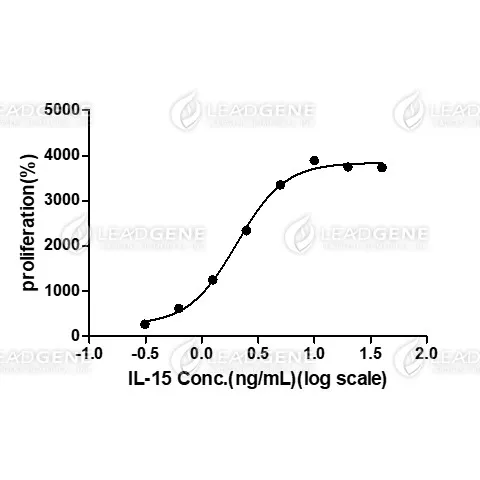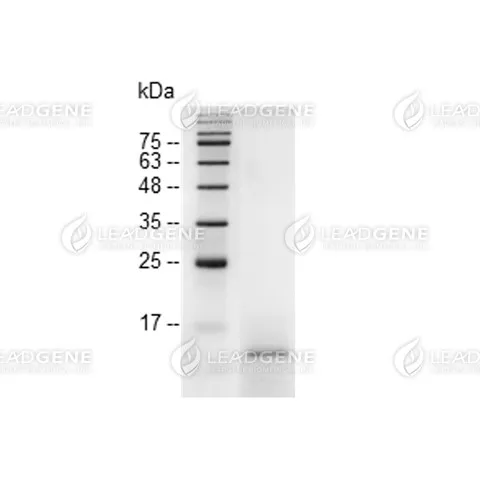-
Species of Origin
Human
Expression System
Escherichia coli
-
Affinity Tag
His Tag (N-term)
Storage Buffer
Lyophilized from a 0.2 µm filtered solution of NaPi buffer, 0.018% SDS, pH 7.5.
-
Purity
>97% as determined by SDS-PAGE analysis.
Molecular weight
The protein has a calculated MW of 13.7 kDa.
The protein migrates as 13 kDa under reducing condition (SDS-PAGE analysis). -
Activity
Measure by its ability to induce proliferation in CTLL-2 cells. The ED₅₀ for this effect is < 3 ng/mL. The specific activity of recombinant LeadGMP® human IL-15 is > 2 x 10⁶ IU/mg, which is calibrated against the human IL-15 WHO International Standard (NIBSC code: 95/554).
Endotoxin Level
<0.05 EU per 1 µg of the protein by the LAL method.
-
Mycoplasma
Not detected
Form
Lyophilized

-
Specifications
-
Background
-
Background
Interleukin-15 (IL-15) is a 14-15 kDa glycoprotein with immune regulatory functions in many diverse cell types. IL-15 can be constitutively expressed in a variety of cell types stored as intracellular protein in the cytoplasm as well as transport to the cell surface, while only secreted from some cell types including monocytes, dendritic cells, epithelial cells, bone marrow stromal cells, and fibroblasts. As a pleiotropic cytokine, IL-15 mediates the crosstalk between innate immunity and adaptive immunity whose principal role is to kill virally infected cells. IL-15 plays a crucial role in the development, differentiation, and survival of NK cells. In monocytes, IL-15 induces the production of IL-8 and monocyte chemotactic protein 1 (MCP-1), which recruits neutrophils and monocytes to sites of infection. IL-15 can also act as a chemo-attractant in T lymphocytes and regulate the differentiation of T lymphocytes.
Synonyms
Interleukin-15
-
Uniprot ID
P40933
Sequence Note
Asn49-Ser162
-
-
Instruction
-
Reconstitution
It is recommended to reconstitute the lyophilized protein in sterile H₂O to a concentration not less than 0.5 mg/mL and incubate the stock solution for at least 20 min to ensure sufficient re-dissolved.
Shipping
The product is shipped with polar packs. Upon receipt, store it immediately at -20°C or lower for long term storage.
-
Stability & Storage
This product is stable after storage at:
- -20°C for 12 months in lyophilized state from date of receipt.
- -20°C or -80°C for 1 month under sterile conditions after reconstitution.
Avoid repeated freeze/thaw cycles.
Manufacturing Specifications
LeadGMP® recombinant proteins are manufactured in ISO 13485:2016 and GMP certified facility. The processes include:
- Animal-free reagent and laboratory
- Manufactured and tested under GMP guideline
- Testing and traceability of raw material
- Records of the maintenance and equipment calibration
- Personnel training records
- Batch-to-batch consistency
- Documentation of QA control and process changes
- Manufactured and tested under an ISO 13485:2016 certified quality management system
- Stability monitor of product shelf-life
-
-
Image
1/2 -
Review

Help others learn more about this product. Use the link below to share your experience.
-
Publication

There are currently no publications. Use the link below to let us know.
-
Datasheet & Documents
1/1
Disclaimer:For Research Use or Further Manufacturing Only.

